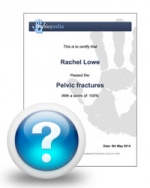Timed Up and Go Test (TUG): Difference between revisions
mNo edit summary |
Evan Thomas (talk | contribs) mNo edit summary |
||
| Line 2: | Line 2: | ||
'''Original Editor '''- [[User:David Csepe|David Csepe]] | '''Original Editor '''- [[User:David Csepe|David Csepe]] | ||
'''Top Contributors''' - {{Special:Contributors/{{FULLPAGENAME}}}} | '''Top Contributors''' - {{Special:Contributors/{{FULLPAGENAME}}}} | ||
</div> | </div> | ||
== Objective | |||
== Objective == | |||
[[Image:Blender3D NormalWalkCycle.gif|right]] | [[Image:Blender3D NormalWalkCycle.gif|right]] | ||
To determine fall risk and measure progress of balance, sit to stand, and walking. | To determine fall risk and measure the progress of balance, sit to stand, and walking. | ||
== Intended Population<br> == | == Intended Population<br> == | ||
| Line 20: | Line 21: | ||
The patient starts in a seated position. | The patient starts in a seated position. | ||
The patient stands up upon therapist’s command | The patient stands up upon therapist’s command walks 3 meters, turns around, walks back to the chair and sits down. | ||
The time stops when the patient is seated. | The time stops when the patient is seated. | ||
| Line 26: | Line 27: | ||
The subject is allowed to use an assistive device. Be sure to document the assistive device used. | The subject is allowed to use an assistive device. Be sure to document the assistive device used. | ||
'''<u>NOTE:</u>''' A | '''<u>NOTE:</u>''' A practice trial should be completed before the timed trial | ||
'''<u>Cut-off time for high risk of falls:</u>''' | '''<u>Cut-off time for high risk of falls:</u>''' | ||
| Line 36: | Line 35: | ||
<br> | <br> | ||
Example score sheet | Example score sheet {{pdf|TUG Score Sheet.pdf|TUG score sheet}} | ||
{{#ev:youtube|grrYoBucNPE}}<ref>Physiotutors. The Timed Up and Go Test (TUG) | Fall Risk Assessment. Available from: https://www.youtube.com/watch?v=grrYoBucNPE</ref> | {{#ev:youtube|grrYoBucNPE}}<ref>Physiotutors. The Timed Up and Go Test (TUG) | Fall Risk Assessment. Available from: https://www.youtube.com/watch?v=grrYoBucNPE</ref> | ||
| Line 48: | Line 47: | ||
=== Validity === | === Validity === | ||
Construct validity has been shown by correlating TUG scores with[[Gait Cycle|gait]] speed (Pearson r = .75), postural sway (Pearson r = -.48), step length (Pearson r = -.74), Barthel Index (Pearson r = -.79), and step frequency (Pearson r = -.59).<ref name="Steffen" /> | Construct validity has been shown by correlating TUG scores with [[Gait Cycle|gait]] speed (Pearson r = .75), postural sway (Pearson r = -.48), step length (Pearson r = -.74), Barthel Index (Pearson r = -.79), and step frequency (Pearson r = -.59).<ref name="Steffen" /> | ||
=== | === Sensitivity and Specificity === | ||
The sensitivity and specificity have been reported to be 87% each in a study by Shumway-Cook et al in 2000. | |||
=== | === Minimally Detectable Change === | ||
The MDC was 4.09 seconds in patients with Alzheimers. | The MDC was 4.09 seconds in patients with Alzheimers. In patients with Parkinson's the MDC was 3.5 seconds. | ||
A study published in 2011 by Resnik et al<ref name="resnik">Resnik, L. and Borgia, M., (2011). Reliability of outcome measures for people with lower-limbfckLRamputations: distinguishing true change from statistical error. Physical Therapy, 91(4), pp. 555-565.</ref> aimed to calculate the minimal detectable change (MDC) for a range of measures used in amputee rehab. The MDC was presented in absolute values for: | A study published in 2011 by Resnik et al<ref name="resnik">Resnik, L. and Borgia, M., (2011). Reliability of outcome measures for people with lower-limbfckLRamputations: distinguishing true change from statistical error. Physical Therapy, 91(4), pp. 555-565.</ref> aimed to calculate the minimal detectable change (MDC) for a range of measures used in amputee rehab. The MDC was presented in absolute values for: | ||
| Line 65: | Line 64: | ||
*AMP (3.4pts). [[Amputee Mobility Predictor]]<br> | *AMP (3.4pts). [[Amputee Mobility Predictor]]<br> | ||
== Read 4 Credit == | == Read 4 Credit == | ||
<div class="coursebox"> | <div class="coursebox"> | ||
| Line 89: | Line 84: | ||
<references /> | <references /> | ||
[[Category:Outcome_Measures]] [[Category:Assessment]] [[Category:Older_People/Geriatrics]] [[Category:Neurology Outcome Measures]] | |||
Revision as of 18:50, 3 November 2017
Original Editor - David Csepe
Top Contributors - David Csepe, Kim Jackson, Siobhán Cullen, Admin, Lucinda hampton, Tarina van der Stockt, Abbey Wright, Laura Ritchie, Wendy Walker, Scott Buxton, Sheik Abdul Khadir, WikiSysop, Shaimaa Eldib, Lauren Lopez, Stacy Schiurring, Evan Thomas, Naomi O'Reilly, Kai A. Sigel, Karen Wilson, 127.0.0.1, Vidya Acharya and Tony Lowe
Objective[edit | edit source]
To determine fall risk and measure the progress of balance, sit to stand, and walking.
Intended Population
[edit | edit source]
This test was initially designed for elderly persons, but is used for people with Parkinsons, Multiple Sclerosis, hip fracture, Alzheimer, CVA, Huntington Disease and others.
Method of Use[edit | edit source]
Materials Needed: one chair with armrest, stopwatch, tape (to mark 3 meters).
The patient starts in a seated position.
The patient stands up upon therapist’s command walks 3 meters, turns around, walks back to the chair and sits down.
The time stops when the patient is seated.
The subject is allowed to use an assistive device. Be sure to document the assistive device used.
NOTE: A practice trial should be completed before the timed trial
Cut-off time for high risk of falls:
Cut-off times to classify subjects as high risk for falling vary based on the study and participants. By using regression analysis Shumway-Cook used 14 seconds as the cut-off.[1] Thus, if a subject took 14 seconds or longer he or she was classified as high-risk for falling.[1]
Example score sheet TUG score sheet
Evidence[edit | edit source]
Reliability[edit | edit source]
Intratester and intertester reliability have been reported as high in elderly populations, from .92-.99.[3] However, reliability in community-dwelling populations has been found to be moderate (.56).[3] In people with Alzheimers disease reliability is high (ICC = .985-.988).[4] A study by Huang et al[5] reported an ICC of 0.80 for subjects with Parkinson's Disease.
Validity[edit | edit source]
Construct validity has been shown by correlating TUG scores with gait speed (Pearson r = .75), postural sway (Pearson r = -.48), step length (Pearson r = -.74), Barthel Index (Pearson r = -.79), and step frequency (Pearson r = -.59).[3]
Sensitivity and Specificity[edit | edit source]
The sensitivity and specificity have been reported to be 87% each in a study by Shumway-Cook et al in 2000.
Minimally Detectable Change[edit | edit source]
The MDC was 4.09 seconds in patients with Alzheimers. In patients with Parkinson's the MDC was 3.5 seconds.
A study published in 2011 by Resnik et al[6] aimed to calculate the minimal detectable change (MDC) for a range of measures used in amputee rehab. The MDC was presented in absolute values for:
- 2MWT (34.3m), Two Minute timed walk test
- 6MWT (45m), _6_Minute_Walk_Test
- TUG (3.6s), and
- AMP (3.4pts). Amputee Mobility Predictor
Read 4 Credit[edit | edit source]
|
Would you like to earn certification to prove your knowledge on outcome measures for balance and mobility? All you need to do is pass the quiz relating to this page in the Physiopedia member area. |
References[edit | edit source]
- ↑ 1.0 1.1 Shumway-Cook A, Brauer S, Woollacott M. Predicting the probability for falls in community-dwelling older adults using the timed up & go test. Phys Ther. 2000;80(9):896-903.
- ↑ Physiotutors. The Timed Up and Go Test (TUG) | Fall Risk Assessment. Available from: https://www.youtube.com/watch?v=grrYoBucNPE
- ↑ 3.0 3.1 3.2 Steffen T, Hacker T, Mollinger L. Age- and gender-related test performance in community-dwelling elderly people: six-minute walk test, berg balance scale, timed up go test, and gait speeds. Phys Ther. 2002;82(2):128-137.
- ↑ Ries J, Echternach J, Nof L, Blodgett M. Test-retest reliability and minimal detectable change scores for the timed "up go" test, the six-minute walk test, and gait speed in people with alzheimer disease. Phys Ther. 2009;89(6):569-579.
- ↑ Huang S, Hsieh C, Wu R, Tai C, Lin C, Lu W. Minimal detectable change of the timed "up go" test and the dynamic gait index in people with parkinson disease. Phys Ther. 2011;91(1):114-121.
- ↑ Resnik, L. and Borgia, M., (2011). Reliability of outcome measures for people with lower-limbfckLRamputations: distinguishing true change from statistical error. Physical Therapy, 91(4), pp. 555-565.








